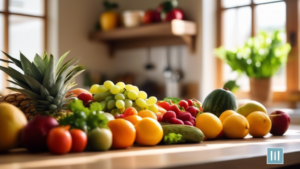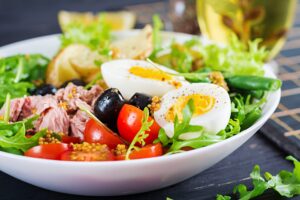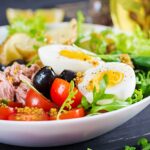Do you find yourself struggling to maintain a balanced diet due to your hectic schedule? As you juggle work, family, and other responsibilities, meal planning often takes a backseat. However, taking the time to plan and prepare nutritious meals can have a profound impact on your overall health and well-being. In this article, you will discover practical tips and strategies to help you succeed in meal planning, even with a busy schedule.
By understanding your nutritional needs and the importance of incorporating variety and balance into your meals, you can ensure that you are fueling your body with the necessary nutrients it needs to thrive. Meal prepping and batch cooking can save you time and energy during the week, making it easier to stick to your meal plan.
With quick and healthy recipe ideas at your fingertips, you can easily whip up nutritious meals in no time. Prioritizing time management for meal planning will help streamline the process and make it more manageable, even on the busiest of days. Stay tuned for practical advice and inspiration to help you achieve success in balanced meal planning.
Key Takeaways
- Importance of meal planning for overall health and well-being
- Practical tips and strategies for successful meal planning
- Incorporating variety and balance into meals
- Utilizing batch cooking and kitchen tools to simplify the process
Understanding Nutritional Needs
You already know how important it is to fuel your body with the right nutrients, but do you understand your specific nutritional needs for a balanced meal plan? It’s not just about eating a variety of foods; it’s about getting the right balance of carbohydrates, proteins, fats, vitamins, and minerals to support your overall health and energy levels.
Take the time to learn about your individual needs based on factors like age, gender, activity level, and any specific health concerns you may have. Once you have a better understanding of your nutritional needs, you can start planning balanced meals that will provide you with the energy and nutrients you need to thrive.
Consider incorporating a variety of colorful fruits and vegetables, lean proteins, whole grains, and healthy fats into your meals. Don’t forget to stay hydrated and listen to your body to adjust your meal plan accordingly. By focusing on meeting your specific nutritional needs, you’ll be setting yourself up for success on your busy schedule.
Meal Prepping and Batch Cooking
When it comes to meal prepping and batch cooking, organization is key to saving time and effort.
For example, think of it like preparing a recipe for a big gathering – the more you do ahead of time, the smoother everything will go on the day of the event.
To make meal prepping more enjoyable and efficient, consider the following tips:
- Set aside dedicated time: Block out a specific time each week to focus on meal prepping. This will help you stay on track and ensure that you have everything you need for the upcoming days.
- Plan your meals: Create a meal plan for the week ahead, including breakfast, lunch, and dinner. This will prevent last-minute decisions and help you stick to your nutritional goals.
- Use versatile ingredients: Choose ingredients that can be used in multiple dishes to save time and reduce waste. For example, roasted vegetables can be added to salads, wraps, or bowls throughout the week.
By incorporating these strategies into your meal-prepping routine, you can streamline the process and make it more enjoyable, even on a busy schedule. The effort you put into preparing healthy meals will pay off in the long run for both yourself and those you serve.
Incorporating Variety and Balance
Incorporating a wide range of flavors and nutrients is key to keeping your meals interesting and satisfying. By adding variety to your meals, you not only prevent taste bud boredom but also ensure you’re getting a good mix of essential nutrients. To help you plan your balanced meals, consider creating a weekly meal schedule that includes different food groups and flavors. Here’s a simple table to guide you in incorporating variety and balance into your meals:
| Meal Type | Protein Sources | Carbohydrate Sources | Vegetable Choices |
|---|---|---|---|
| Breakfast | Eggs, Greek yogurt | Oatmeal, whole grain toast | Spinach, tomatoes |
| Lunch | Chicken, tofu | Quinoa, brown rice | Broccoli, bell peppers |
| Snack | Almonds, cottage cheese | Fruits, whole grain crackers | Carrots, cucumber |
| Dinner | Salmon, lentils | Sweet potatoes, pasta | Zucchini, asparagus |
By having a mix of protein, carbohydrates, and vegetables in your meals, you can create a balanced plate that will keep you satisfied and energized throughout the day. Don’t be afraid to experiment with new ingredients and recipes to keep things exciting and delicious!
Quick and Healthy Recipe Ideas
Try whipping up a tasty and nutritious quinoa salad for a quick and healthy meal option. Start by cooking some quinoa according to the package instructions and let it cool. Then, mix in some chopped vegetables like bell peppers, cucumbers, and cherry tomatoes. Add in some protein like grilled chicken or chickpeas for a satisfying meal.
Drizzle with a homemade vinaigrette dressing made with olive oil, lemon juice, and a dash of honey. This salad is not only delicious but also packed with nutrients to keep you energized throughout your busy day. If you need a quick and easy dinner option, try making a stir-fry with your favorite vegetables and lean protein. Simply sauté some garlic and ginger in a pan, and add in your choice of veggies like broccoli, bell peppers, and snap peas.
Toss in some cooked chicken, tofu, or shrimp for added protein. Season with soy sauce, sesame oil, and a sprinkle of sesame seeds for a flavorful dish. Serve over brown rice or quinoa for a complete and balanced meal that can be ready in no time. These quick and healthy recipe ideas are perfect for those hectic days when you need a nutritious meal without the hassle.
Prioritizing Time Management for Meal Planning
Prioritize your tasks by setting aside dedicated time each week for efficient meal preparation. Here are three tips to help you manage your time effectively and make meal planning a breeze:
- Create a meal plan for the week ahead on a Sunday evening, allowing you to have a clear roadmap for your meals and the ingredients needed.
- Utilize batch cooking to prepare larger quantities of food at once, saving you time during the week for other tasks.
- Make use of kitchen tools such as slow cookers or pressure cookers to simplify cooking processes and reduce the time spent on meal preparation.
By prioritizing your time management for meal planning, you can ensure that you have nutritious meals ready to enjoy throughout the week without sacrificing your busy schedule.
Frequently Asked Questions
Can meal planning help with weight loss or weight management goals?
Meal planning serves as a compass guiding you towards your weight goals. By mapping out nutritious meals, you create a roadmap for success. It’s like planting seeds of health that blossom into your desired weight.
How can I ensure I am getting enough nutrients and vitamins in my balanced meals?
To ensure you’re getting enough nutrients and vitamins in your meals, focus on incorporating a variety of colorful fruits and vegetables, lean proteins, whole grains, and healthy fats. Don’t forget to stay hydrated and listen to your body’s hunger and fullness cues.
Is it possible to accommodate dietary restrictions or allergies in meal planning?
Accommodating dietary restrictions or allergies in meal planning is definitely possible! Get creative with substitutions like almond milk for dairy or quinoa for gluten. Explore new recipes that cater to your needs and taste buds.
Are there any recommended portion sizes or guidelines to follow?
When considering portion sizes, aim for a balanced plate with half veggies, a quarter protein, and a quarter whole grains. Listen to your body’s hunger cues and stop when you’re satisfied. Enjoy your meals mindfully!
How can I avoid food waste while meal planning and prepping?
To avoid food waste while meal planning and prepping, think of your ingredients as characters in a story. Use them creatively in multiple dishes, freeze extras for later, and compost scraps to complete the tale.














